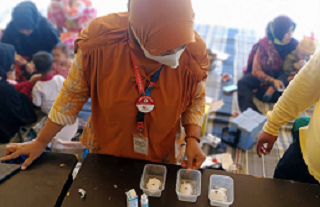Utilization of iodized salt in Halahalaya Hamlet, Kanreapia Village, Gowa Regency
Abstract
Salt is a dietary supplement and source of electrolytes for the human body. Salt contains iodine. Iodine is a trace mineral that must be present in the body to form thyroid hormones and is beneficial for the body's metabolism. Iodine deficiency leads to goiter disease at various stages, slows growth in children and adults, as well as lowers labour productivity. The purpose of this service activity is to find out the use of iodized salt in Halahalaya Hamlet, Kanreapia Village. This type of service is an observational activity with a population consisting of heads of households in 92 households in Halahalaya Village. Data on the use of iodized salt were collected through interviews and direct observation using questionnaires. The results of the service showed that out of 92 households, 87 households (94.6%) used packaged salt labelled iodine, 5 households (5.4%) did not use packaged salt labelled iodine, iodine test results of 12 households were white (13.0%). ), light purple iodine test results in 20 households (21.7%), dark purple iodine test results in 60 households (65.2%). The conclusion of the service is that the availability of iodized salt in Halahalaya Hamlet, Kanreapia Village is sufficient, but there is still a lack of community understanding of the use of good iodized salt, therefore cross-disciplinary cooperation is needed to a growing community knowledge.
References
Agustin, H., Budiman, H., & Faiza, Y. (2015). Faktor yang Berhubungan dengan Kejadian Gangguan Akibat Kekurangan Yodium di Kecamatan Koto Tangah, Padang. Jurnal Kesehatan Komunitas, 2(6), 262–269.
Akbar, H., Nur, N. H., Paundanan, M., Studi, P., Masyarakat, K., Kesehatan, F., & Universitas, M. (2021). Pengetahuan Ibu Berkaitan Dengan Penggunaan Garam Beryodium Di Tingkat Rumah Tangga Di Desa Muntoi Kecamatan Passi Barat. 11(2), 389–393.
Anggraeni, E., Palupi, M., & Trisnagati, R. (2020). Perubahan Status Gizi Balita Dengan Akupresur Selama Pemberian Makanan Tambahan (PMT) Pemulihan Pada Balita. Jurnal Gizi Prima (Prime Nutrition Journal), 5(2), 75.
Asikin, H., & Anggraeni, P. (2022). Acceptance and Iodine Content of Cookies With Addition of Brown Seaweed Flour (Eucheuma Cottonii). Media Gizi Pangan, 29(2), 15.
Astutik, V. Y. (2017). Tingkat Pengetahuan, Pola Kebiasaan Lingkungan Hidup Berhubungan Dengan Motivasi Ibu Dalam Memilih Kondisi Garam. Care : Jurnal Ilmiah Ilmu Kesehatan, 5(2), 220.
Elia, M. (2017). Defining, recognizing, and reporting malnutrition. The international journal of lower extremity wounds, 16(4), 230-237.
Godswill, A. G., Somtochukwu, I. V., Ikechukwu, A. O., & Kate, E. C. (2020). Health benefits of micronutrients (vitamins and minerals) and their associated deficiency diseases: A systematic review. International Journal of Food Sciences, 3(1), 1-32.
Hatch-McChesney, A., & Lieberman, H. R. (2022). Iodine and iodine deficiency: a comprehensive review of a re-emerging issue. Nutrients, 14(17), 3474.
Kementerian Kesehatan RI. (2018). Riskendas 2018. Laporan Nasional Riskesndas 2018, 44(8), 181–222.
Kusmita, A., & Mandagi, A. M. (2021). Gambaran Penggunaan Garam Beryodium di Desa Telemung Kecamatan Kalipuro Kabupaten Banyuwangi. Preventia : The Indonesian Journal of Public Health, 6(1), 7.
Lamid, A., Hartati, N. S., Fitriana, F., & Driyah, S. (2018). Penanganan Balita Gizi Buruk di Puskesmas Provinsi Banten, Jawa Barat, Kalimantan Barat, dan Nusa Tenggara Timur. Jurnal Penelitian dan Pengembangan Pelayanan Kesehatan, 175-183.
Laswati, D. T. (2019). Masalah Gizi Dan Peran Gizi Seimbang. Agrotech : Jurnal Ilmiah Teknologi Pertanian, 2(1), 69–73.
Muftiana, E., & Munawaroh, S. (2016). Kadar Yodium Garam Rumah Tangga di Desa Krebet Kabupaten Ponorogo. Jurnal Keperawatan, 7(1), 22-26.
Nugroho, T. W., Margawati, A., & Utami, A. (2021). Hubungan Karakteristik, Pola Konsumsi Garam Dan Pola Makan Dengan Kadar Ekskresi Iodium Urin (Eiu) Pada Ibu Hamil Di Jepara, Jawa Tengah. Journal of Nutrition College, 10(1), 47-54.
Pratiwi, D. A., Prihanti, G. S., & Setyawan, F. E. B. (2015). Hubungan Antara Pengetahuan Keluarga Dan Pola Konsumsi Pangan Terhadap Kejadian Gondok Pada Anak Usia Sekolah Di SDN Pandansari 02 Kecamatan Poncokusumo Kabupaten Malang. Saintika Medika, 11(1), 45-57

Copyright (c) 2024 Syarfaini Syarfaini, Surahmawati Surahmawati, Andi Syamsiah Adha, Nurfadilla Nurfadilla, Nabila Harfayani, Muhammad Alflirian Thamrin

This work is licensed under a Creative Commons Attribution-NonCommercial-ShareAlike 4.0 International License.
